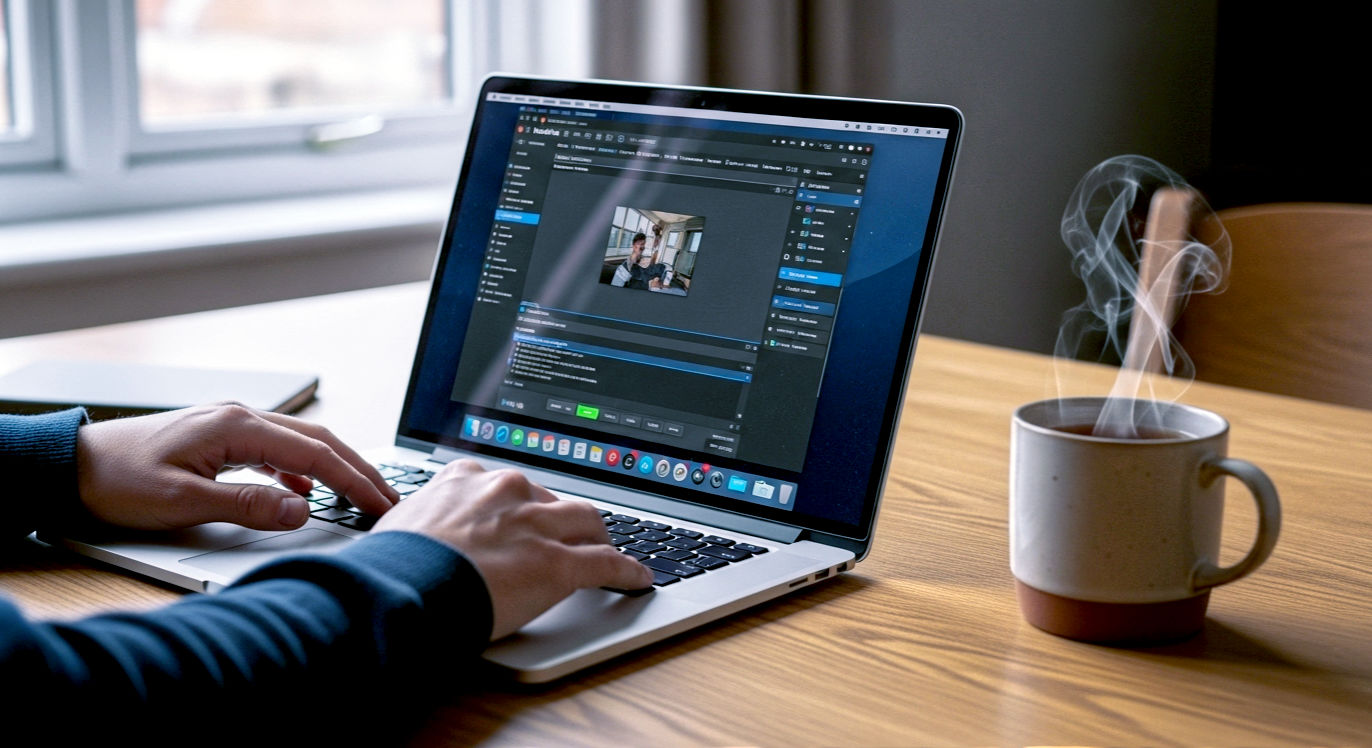The Guide to Compressing Videos Without Losing Quality: A Definitive Handbook for Brits
Your ultimate guide to shrinking video files. Discover the best free tools and settings to compress videos for web, email, and social media without losing quality.

This post may contain affiliate links. If you make a purchase through these links, we may earn a commission at no additional cost to you.
Ever tried to send a video of the family kickabout in the garden, only to have your phone tell you the file is too big? Or maybe you’ve uploaded a clip to your business website, and it takes an eternity to load, leaving visitors staring at a spinning wheel. It’s a classic British problem: we love capturing moments, but sharing them can be a right faff.
The culprit is almost always the video file size. They’re massive. A short, one-minute video from your smartphone can easily be hundreds of megabytes. Sending that over WhatsApp or embedding it on a webpage is like trying to shove a sofa through a letterbox. It’s just not going to work.
So, what’s the answer? Video compression.
Now, I know what you might be thinking. “Doesn’t compressing something mean squishing it and making it look… well, rubbish?” It’s a fair question. We’ve all seen those grainy, pixelated videos that look like they were filmed on a potato. That’s what happens when compression goes wrong.
But here’s the secret: it is absolutely possible to shrink your video files down to a manageable size without any noticeable loss in quality. You just need to know how it works and which buttons to press.
This guide is your new best friend for all things video compression. We’ll break it down into simple, bite-sized chunks, with no confusing jargon. Think of me as your friendly local tech expert, popping round for a cuppa and a chat about codecs, bitrates, and containers. By the end, you’ll be able to make your videos smaller, faster, and easier to share, all while keeping them looking sharp and professional. Whether you’re a parent sharing family videos, a small business owner creating marketing content, or just someone who wants to free up space on their computer, this is for you.
Let’s get started.
What is Video Compression, Anyway? A Simple Explanation
Before we dive into the ‘how,’ let’s quickly cover the ‘what.’ Understanding the basics will make everything else click into place.
Imagine you have a flipbook. Each page has a drawing that’s slightly different from the last. When you flick through the pages quickly, it looks like a moving image. A video is basically a digital flipbook, made up of thousands of individual pictures called frames. A typical video shows 25 to 30 frames every single second.
Now, imagine you had to store every single one of those frames as a full-quality picture. That’s a colossal amount of data. Your phone or computer would fill up in no time.
This is where compression comes in. It’s a clever set of tricks to reduce the amount of data needed to store the video. It’s not magic; it’s just very smart maths.
How Does It Actually Work?
Video compression works in two main ways.
- It gets rid of stuff you can’t see (Intra-frame compression): Think about a single frame of your video—a picture of your garden, for example. There’s the bright green of the grass, the blue sky, and the brown fence. Your eyes are brilliant at seeing the big picture, but they aren’t so good at noticing tiny, subtle differences between two very similar shades of green sitting right next to each other. Compression techniques can cleverly merge these similar colours into one, saving space without you ever noticing the change. This is done within a single frame, which is why it’s called intra-frame compression.
- It only records what changes (Inter-frame compression): This is the really clever bit. Let’s go back to that video of the kickabout in the garden. For a few seconds, the only thing that moves is the football. The garden, the sky, the fence—they all stay exactly the same. So, instead of storing the entire background again and again for every single frame, the compression system just stores it once. Then, for the next few frames, it only records the bit that changed—the moving football. It’s like saying, “Keep everything the same as last time, but just move this little ball over here.” This saves an enormous amount of space.
These two techniques work together to shrink the video file. The software that does all this clever work is called a codec.
Codecs, Containers, and Bitrates: Your Three New Best Mates
Okay, we’re going to touch on three technical terms here, but stick with me. They’re much simpler than they sound, and knowing them is the key to mastering video compression.
1. The Codec: The Engine Under the Bonnet
A codec (short for coder-decoder) is the brain of the operation. It’s the specific set of rules and algorithms used to compress (code) and decompress (decode) the video. When you save a video, the codec squishes it down. When you play it, the codec unpacks it so you can watch it.
There are lots of different codecs, but you only really need to know about a couple of them:
- H.264 (also called AVC): This is the old reliable, the Ford Focus of the codec world. It’s been around for years and is supported by virtually every device on the planet, from your smart TV to your Nan’s tablet. It gives you a great balance of quality and file size. If in doubt, use H.264.
- H.265 (also called HEVC): This is the newer, more efficient model—the Tesla of codecs. It can compress a video to be about half the size of an H.264 file while keeping the same quality. The only snag is that it’s not as widely supported yet, especially on older devices. But for modern gadgets, it’s fantastic.
- AV1: This is the new kid on the block, developed by big names like Google, Netflix, and Amazon. It’s even more efficient than H.265, meaning even smaller files for the same quality. It’s the future, but support is still growing. You’ll see this more and more in the coming years.
The takeaway: Your choice of codec is the single biggest factor in determining your final file size. Choosing a modern codec like H.265 or AV1 over an older one will give you a much smaller file.
2. The Container: The Digital Tupperware Box
If the codec is the engine, the container is the body of the car. It’s the file type that holds everything together—the compressed video, the audio, and maybe even subtitles. You’ll recognise these by their file extensions.
Here are the most common ones:
- .MP4: This is the undisputed champion. It’s like a Tupperware box that can hold anything. It works everywhere, supports all the popular codecs (like H.264 and H.265), and is perfect for the web. When you save your video, you’ll almost always want to choose MP4.
- .MOV: This is Apple’s version of MP4. It’s great if you’re working exclusively on Macs, iPhones, and iPads, but it can sometimes be a bit fussy on Windows or other devices.
- .MKV: This one is popular for ripping Blu-rays and DVDs. It’s very flexible and can hold lots of different audio tracks and subtitles, but it’s not as universally supported for web streaming.
- .AVI: An older container format. You don’t see it much these days, and it’s best avoided unless you have a specific reason to use it.
The takeaway: Stick with MP4. It’s the universal standard and will save you a lot of headaches.
3. The Bitrate: The Tap Controlling the Flow of Data
This is the one that really gives you control. The bitrate is the amount of data used to store one second of video. It’s usually measured in megabits per second (Mbps) or kilobits per second (kbps).
Think of it like a tap.
- A high bitrate is like turning the tap on full blast. You’re pouring a lot of data into each second of video, which results in very high quality but also a very large file.
- A low bitrate is like a gentle trickle. You’re using less data per second, which gives you a much smaller file, but if you go too low, the quality will start to suffer and you’ll see those ugly pixels.
The trick is to find the “sweet spot”—the lowest bitrate you can use without anyone noticing a drop in quality. This depends on what’s in your video. A fast-paced action scene with lots of movement needs a higher bitrate to look good, while a simple video of someone talking to the camera (a “talking head”) can get away with a much lower one.
The takeaway: Lowering the bitrate is the most direct way to reduce file size. We’ll look at some recommended bitrate settings later on.
So, to recap: you use a codec (like H.264) to compress your video, then you put it inside a container (like MP4) and control the final size and quality with the bitrate. Simple as that.
The Best Tools for the Job: Free and Paid Software
Now for the fun part: actually compressing your videos. You don’t need to be a Hollywood editor to do this. There are some fantastic, user-friendly tools out there, many of them completely free.
The Free Champions
You don’t need to spend a penny to get professional-grade compression. These are the best free tools available.
1. HandBrake: The Swiss Army Knife of Video Compression
If you only download one tool, make it HandBrake. It’s free, open-source, and runs on Mac, Windows, and Linux. It might look a bit intimidating at first, with all its buttons and menus, but it’s incredibly powerful and surprisingly easy to use once you know your way around.
Why it’s brilliant:
- Presets Galore: HandBrake comes with a huge list of built-in presets. Want to compress a video for your iPhone? There’s a preset for that. For YouTube? Yep. For Discord? You bet. These presets take all the guesswork out of it.
- Total Control: If you want to get your hands dirty, HandBrake lets you tweak every single setting, from the codec and bitrate to more advanced options.
- Batch Processing: Got a whole folder of videos to compress? You can queue them all up in HandBrake and let it work through them while you go and put the kettle on.
A Quick-Start Guide to HandBrake:
- Open Your Video: Drag and drop your video file into the main window.
- Choose a Preset: On the right-hand side, you’ll see a list of presets. A great starting point for web videos is under Web > Vimeo YouTube HQ 1080p60. This gives a fantastic balance. For general use, General > Fast 1080p30 is also a solid choice.
- Check the Summary Tab: Make sure the Format is set to MP4.
- Tweak the Video Tab (Optional but Recommended):
- Video Codec: It will likely default to H.264. If your target devices are modern, try switching to H.265 (x265). You’ll get a smaller file.
- Quality Setting: Instead of setting a specific bitrate, HandBrake uses a ‘Constant Quality’ slider, measured in RF (Rate Factor). It’s a bit counter-intuitive: a lower RF number means higher quality (and a bigger file), while a higher RF number means lower quality (and a smaller file).
- For H.264, an RF of 22-23 is a great sweet spot for 1080p video.
- For H.265, an RF of 24-26 will give you similar quality but a smaller file.
- Set the Destination: At the bottom, click ‘Browse’ to choose where to save your new, compressed file.
- Start Encoding: Click the green ‘Start Encode’ button at the top. Go and make that cuppa.
2. VLC Media Player: The Player That Does More
You probably already have VLC on your computer. It’s famous for being able to play absolutely any video file you throw at it. But did you know it also has a hidden compression feature? It’s not as powerful as HandBrake, but for a quick and simple job, it’s perfect.
How to compress with VLC:
- Open VLC. Go to Media > Convert / Save.
- Click Add to select your video file, then click the Convert / Save button.
- In the Profile dropdown menu, choose a preset. Video – H.264 + MP3 (MP4) is usually the best bet.
- If you want more control, click the little spanner icon next to the profile. Here you can change the codec, bitrate, and resolution.
- Choose a destination for your file and click Start.
It’s a bit more basic, but it’s a tool you likely already have installed.
3. Shutter Encoder: The Professional’s Free Tool
Shutter Encoder is another fantastic, free, and powerful tool. It’s built on a foundation of professional tools used in the film and TV industry, but it has a much friendlier interface than some of the more complex software out there. It’s a great step up from HandBrake if you need even more options.
Why it’s great:
- Huge range of codecs: It supports all the main ones like H.264 and H.265, but also professional ones like DNxHD and ProRes.
- More than just compression: You can use it to cut clips, add watermarks, and even generate LUTs (colour lookup tables).
- Simple interface: Despite its power, the layout is clean. You choose your function from a list, tweak the settings on the right, and hit ‘Start function’.
Paid and Professional Options
If you’re already working with video editing software, the good news is you have powerful compression tools right at your fingertips.
1. Adobe Media Encoder (Part of Premiere Pro)
If you use Adobe Premiere Pro to edit your videos, you should be using Adobe Media Encoder to export and compress them. It’s a dedicated program that gives you incredibly fine-tuned control over your output.
When you export from Premiere Pro (File > Export > Media), you’re essentially using a built-in version of Media Encoder. The key here is to ignore the default presets and create your own.
Tips for Adobe Media Encoder:
- Format: Choose H.264.
- Preset: Start with Match Source – High Bitrate, and then customise it.
- Bitrate Settings: This is where the magic happens. Scroll down to the Bitrate Settings. Change the Bitrate Encoding to VBR, 2 Pass.
- What is VBR, 2 Pass? VBR stands for Variable Bitrate. It means the software will use a higher bitrate for complex, fast-moving parts of your video and a lower bitrate for simple, static parts. This is much more efficient than a constant bitrate (CBR). 2 Pass means the software analyses the entire video once to see where it needs to allocate the bits, and then goes through a second time to do the actual compression. It takes longer, but it gives you the best quality for a given file size.
- Set Your Bitrates: You’ll see two sliders: Target Bitrate and Maximum Bitrate. The target bitrate determines the overall file size. The maximum bitrate tells it how high it’s allowed to go for those complex scenes. We’ll cover specific numbers in the next section.
2. DaVinci Resolve
DaVinci Resolve is an incredibly popular professional editing suite, and its free version is more powerful than many paid ones. Its export page (called the “Deliver” page) offers fantastic compression options.
Similar to Media Encoder, you’ll want to choose the MP4 format, the H.264 or H.265 codec, and then fine-tune the quality settings. Resolve has a ‘Restrict to’ box where you can set your target bitrate in kbps.
The Secret Sauce: Perfect Settings for Any Situation
Okay, you’ve chosen your tool. Now, what settings should you actually use? This is the million-dollar question. The honest answer is: it depends. It depends on the resolution of your video and where it’s going to be watched.
But don’t worry, we can get very close. Here are some tried-and-tested bitrate recommendations. These are a great starting point. You can always nudge them up a bit for higher quality or down a bit for a smaller file.
Remember, these are for H.264. If you’re using the more efficient H.265, you can safely reduce these numbers by about 30-40%.
| Resolution | Use Case | Recommended Target Bitrate (H.264) |
|---|---|---|
| 4K (2160p) | High-quality streaming (YouTube, Vimeo) | 35–45 Mbps |
| Archiving, high-end playback | 50–65 Mbps | |
| 1080p (Full HD) | Standard web video (YouTube, social media) | 8–10 Mbps |
| High-action content (sports, gaming) | 12–15 Mbps | |
| Sending via email/messaging (lower quality) | 2–5 Mbps | |
| 720p (HD) | Good for mobile, faster loading on web | 5–7 Mbps |
| Email/messaging | 1–2.5 Mbps | |
| 480p (SD) | When file size is the absolute priority | 1–2 Mbps |
A Note on Frame Rate: The numbers above generally assume a standard frame rate of 25-30 frames per second (fps). If your video is a higher frame rate (like 50 or 60 fps), you should increase the bitrate by about 1.5 times to maintain quality. For example, for 1080p at 60fps, aim for around 12-15 Mbps instead of 8-10.
Should I Lower the Resolution?
This is a very common question. If you have a 4K video, should you shrink it down to 1080p to save space?
Yes, absolutely. This is one of the easiest and most effective ways to dramatically reduce file size.
Think about it: a 4K video has four times the number of pixels as a 1080p video. That’s a huge amount of extra data. If your video is only going to be watched on a phone, a tablet, or a standard computer screen, nobody is going to see the benefit of that extra 4K detail. Exporting at 1080p will create a file that is drastically smaller and will look just as good on most screens.
When to keep 4K: Keep your video in 4K if you know it will be watched on a large 4K TV, or if you want the highest possible quality for archiving or for platforms like YouTube, which handle 4K video very well.
Common Pitfalls and How to Avoid Them
Compressing video is part science, part art. It’s easy to make a few common mistakes that can leave you with a video that looks worse than it should. Here’s what to watch out for.
1. The Dreaded Re-compression
This is the number one sin of video compression. Every single time you compress a video, you lose a little bit of quality, even if you can’t see it. The losses are cumulative.
Imagine photocopying a document, then photocopying the photocopy, then photocopying that one. Each time, the image gets a little bit fuzzier. It’s the same with video.
The Golden Rule: Always, always, always start with your original, uncompressed source file. Don’t download a video from WhatsApp, compress it, then upload it to YouTube. Find the original clip that came straight from your camera or phone. That’s your ‘master’ copy. Any compression you do should start from that.
2. Using CBR Instead of VBR
We touched on this earlier. CBR (Constant Bitrate) uses the same amount of data for every second of video, whether it’s a still, silent shot or a massive explosion. VBR (Variable Bitrate) is smarter, allocating more data to the complex parts.
Using VBR (especially 2-Pass VBR) will almost always give you a better-looking video for the same file size. If you have the option, choose VBR.
3. Forgetting About the Audio
We’ve talked a lot about the video, but the audio is part of the file size too! Luckily, audio data is much smaller than video data, but you can still make some savings.
When you export your video, you’ll see audio settings.
- Codec: Choose AAC. It’s the standard and it’s excellent.
- Bitrate: For most purposes, 128 kbps or 192 kbps is absolutely fine for stereo audio. You really don’t need to go higher than that unless you’re a professional sound engineer. Dropping from 320 kbps to 192 kbps can shave a surprising amount off your final file size with no audible difference for most people.
4. Not Doing a Test Run
Compression can take time, especially on longer videos. It’s soul-destroying to wait an hour for a video to export, only to find you set the bitrate too low and it looks like a mess.
Always do a test. Export a small, 10-second section of your video using the settings you’ve chosen. Pick a section with a bit of movement and detail. If that 10-second clip looks good, you can confidently set the whole video to compress and go and have that cup of tea (or maybe even a biscuit this time).
The Future of Compression: What’s Next?
The world of video technology moves at a blistering pace. Codecs are constantly getting smarter and more efficient. We’ve already mentioned AV1, which is leading the charge. As more devices and platforms adopt it, we’ll be able to stream higher-quality video using less data and less bandwidth, which is great for everyone.
Artificial Intelligence (AI) is also starting to play a huge role. New AI-powered compression techniques are being developed that can understand the content of a video. They can identify the most important parts (like a person’s face) and make sure those parts get the most data, while being more aggressive in compressing the less important background. This is a big leap beyond the simple motion-based approach of VBR.
The goal is always the same: to deliver the best possible picture quality in the smallest possible package. As our screens get bigger and our resolutions get higher (hello, 8K!), the need for smarter compression will only grow.
Your Compression Checklist: A Final Summary
We’ve covered a lot of ground, so let’s boil it all down to a simple checklist. The next time you need to compress a video, just run through these steps.
- Start with the Original: Find the highest-quality version of your video.
- Choose Your Tool: For most people, HandBrake is the perfect choice. If you’re a pro, use the tools in your editing software.
- Select Your Container: Choose MP4. No ifs, no buts.
- Pick Your Codec:
- H.264 for maximum compatibility.
- H.265 for better efficiency if you know it will be played on modern devices.
- Decide on Resolution: Don’t be afraid to downsize from 4K to 1080p for web and social media. It’s the biggest and easiest win.
- Set Your Bitrate (The Key Step):
- Use VBR (2-Pass) if available.
- For 1080p video, start with a target bitrate of 8-10 Mbps.
- Adjust based on the content (more for action, less for talking heads).
- Alternatively, in HandBrake, use the Constant Quality (RF) setting. Aim for 22 for H.264 or 24 for H.265.
- Check Your Audio: Set the audio to AAC at 192 kbps.
- Run a Quick Test: Export a small clip first to check the quality.
- Compress! Let the software do its work.
And that’s it. That is the secret to shrinking your video files without sacrificing quality. It’s not black magic, just a few simple settings. By understanding what codecs, containers, and bitrates are, you’ve taken control. No more fighting with massive files. No more waiting an age for uploads. Just crisp, clean video that’s ready to share with the world. Now, go and give it a try.
Further Reading:
- HandBrake Documentation: https://handbrake.fr/docs/
- Google/YouTube Recommended Upload Encoding Settings: https://support.google.com/youtube/answer/1722171
- Vimeo Video Compression Basics: https://vimeo.com/blog/post/how-to-compress-a-video
- TechRadar’s Guide to Video Codecs: https://www.techradar.com/news/home-cinema/best-codecs-for-video-and-how-to-encode-1044575
- Shutter Encoder Official Site: https://www.shutterencoder.com/en/






